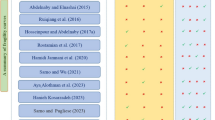Abstract
The aim of the present paper is to evaluate by means of nonlinear dynamic analysis four different procedures for the selection of sectional forces needed for the design of R/C frames. For this purpose, a single-story building is designed using four different procedures to select the sets of internal forces needed for the calculation of longitudinal reinforcement. All the four procedures are based on the results of linear response history analysis. Nonlinear dynamic analyses under 16 bi-directional ground motions are performed for 4 different seismic intensity levels. The two horizontal accelerograms of each ground motion are applied along horizontal orthogonal axes forming with the structural axes several incident angles. The results of this study demonstrate that one of the investigated procedures that takes into account the critical seismic angle is more efficient for the design of R/C frame elements.
Similar content being viewed by others
References
American Society of Civil Engineers (ASCE 41-06) (2009) Seismic rehabilitation of existing buildings
Amiri JV, Ahmadi QY et al (2008) Assessment of reinforced concrete buildings with shear wall based on Iranian Seismic Code (Third edition). J Appl Sci 8(23): 4274–4283
Arjomandi K, Estekanchi H et al (2009) Correlation between structural performance levels and damage indexes in steel frames subjected to earthquakes. Sci Iranica Trans Civil Eng 16(2): 147–155
Athanatopoulou AM (2005) Critical orientation of three correlated seismic components. Eng Struct 27: 301–312
Carr AJ (2004) Ruaumoko—a program for inelastic time-history analysis, Program manual. Department of Civil Engineering, University of Canterbury, New Zealand
CEB-FIP. CEB-FIP (1982) Manual on bending and compression—design of sections under axial action effects at the ultimate limit state, CEB Bulletin d’Information No. 141, Lausanne, Switzerland
CEB-FIP. CEB-FIP (1991) Model code 1990, CEB Bulletin d’Information No. 203-204-205, Lausanne, Switzerland
CEN (1991) Eurocode 2: design of concrete structures. 1: General rule and rules for buildings. ENV 1992-1-1, Brussels
Dimova SL, Negro P (2005) Seismic assessment of an industrial frame structure designed according to Eurocodes. Part 2: capacity and vulnerability. Eng Struct 27(5): 724–735
EAK: (2003) Greek code for earthquake resistant design of structures. Ministry of Environment, Planning and Public Works, Greece
EKOS: (2000) Greek code for the design and construction of concrete works. Greek Ministry of Environment, Planning and Public Works, Greece
Elenas A (2000) Correlation between seismic acceleration parameters and overall structural damage indices of buildings. Soil Dyn Earthq Eng 20(1–4): 93–100
Federal Emergency Management Agency (FEMA): (2000) Prestandard and commentary for the seismic rehabilitation of buildings. FEMA 356, Washington, DC
(2004) Improvement of nonlinear static seismic analysis procedures. FEMA 440, Washington, DC
Federal Emergency Management Agency (FEMA): (2009) Recommended seismic provisions for new buildings and other structures. FEMA P-750 (NEHRP), Washington, DC
Fontara I-KM, Kostinakis KG, Athanatopoulou AM (2012) Some issues related to the inelastic response of buildings under Bi-directional excitation. In: Proceedings of 15th world conference on earthquake engineering, Lisbon, paper No 3715
Kostinakis KG, Athanatopoulou AM, Avramidis IE (2008) Selection of sectional forces for designing r/c frames analysed by time history analysis. In: Proceedings of 14th world conference on earthquake engineering, Beijing, paper 08-02-0010
Kostinakis KG, Athanatopoulou AM, Avramidis IE (2011) Sectional forces for seismic design of R/C frames by linear time history analysis and application to 3D single-story buildings. Soil Dyn Earthq Eng 31: 318–333
Kunnath SK, Reinhorn AM, et al. (1992) IDARC Version 3: A program for the inelastic damage analysis of RC structures, Technical report NCEER-92-0022. National centre for earthquake engineering research, State University of New York, Buffalo
Lagaros ND (2010) Multicomponent incremental dynamic analysis considering variable incident angle. Struct Infrastruct Eng 6: 77–94
Lagaros ND (2010) The impact of the earthquake incident angle on the seismic loss estimation. Eng Struct 32: 1577–1589
Lucchini A, Monti G, Kunnath S (2011) Nonlinear response of two-way asymmetric single-story building under biaxial excitation. J Struct Eng 137(1): 34–40
MacRae GA, Mattheis J (2000) Three-dimensional steel building response to near-fault motions. J Struct Eng 126(1): 117–126
Pacific Earthquake Engineering Research Centre (PEER) (2003) Strong motion database. http://peer.berkeley.edu/smcat/
Park YJ, Ang AH-S et al (1987) Damage-limiting aseismic design of buildings. Earthq Spectra 3(1): 1–26
Park YJ, Ang AH-S (1985) Mechanistic seismic damage model for reinforced-concrete. J Struct Eng-ASCE 111(4): 722–739
Penzien J, Watane M (1975) Characteristics of 3-D earthquake ground motions. Earthq Eng Struct Dyn 3: 365–373
Rigato AB, Medina RA (2007) Influence of angle of incidence on seismic demands for inelastic single-storey structures subjected to bi-directional ground motions. Eng Struct 29(10): 2593–2601
Williams MS, Sexsmith RG (1997) Seismic assessment of concrete bridges using inelastic damage analysis. Eng Struct 19(3): 208–216
Yüksel E, Sürmeli M (2010) Failure analysis of one-story precast structures for near-fault and far-fault strong ground motions. Bull Earthq Eng 8: 937–953
Author information
Authors and Affiliations
Corresponding author
Rights and permissions
About this article
Cite this article
Kostinakis, K.G., Athanatopoulou, A.M. & Avramidis, I.E. Evaluation of inelastic response of 3D single-story R/C frames under bi-directional excitation using different orientation schemes. Bull Earthquake Eng 11, 637–661 (2013). https://doi.org/10.1007/s10518-012-9392-5
Received:
Accepted:
Published:
Issue Date:
DOI: https://doi.org/10.1007/s10518-012-9392-5




